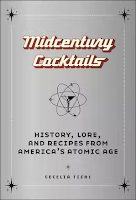TYPORAMA
***********
PRAISE FOR MIDCENTURY COCKTAILS: HISTORY, LORE, AND RECIPES:
“Illustrations and recipe lists accompany each chapter; these are visual, flavorful ways to engage with the book’s cultural history lessons. Some of the recipes assume access to special ingredients like orzata and falernum, but one imagines that, in the generous American spirit of adventurousness, mixologists can improvise as needed. Midcentury Cocktails is a delightful, is a delightful, nostalgic trip through the 1950s and 1960s with recipes for recreating Atomic Age intoxications.” —Foreword Reviews
************
ABOUT MIDCENTURY COCKTAILS: HISTORY, LORE, AND RECIPES:
Midcentury Cocktails spans the 1950s to the early 1960s, a time of innovation, style, and leisure, as well as anxieties around the Cold War and the dawn of the Atomic Age.
The hallmark of this new era was social drinking, and the cocktail classics prevailed.
The Martini and Old Fashioned reached new heights of prestige and popularity thanks to the new class of “Mad men,” the ad executives who worked on Madison Avenue, dominated the media and exerted vast power in the shaping of popular standards.
The book shows the extreme influence the rise of advertising had on alcohol consumption and trends.
Even as Americans learned to “duck and cover,” the bomb inspired new concoctions, and the book includes recipes for drinks like the Apricot Fission (a mix of apricot brandy and tangerine juice) and the Rocket Man (a rum and vodka cocktail which was set on fire before serving).
Through anecdotes paired with recipes of featured cocktails at the end of each chapter, Midcentury Cocktails contextualizes cocktails within the history and politics of midcentury America.
************
SOME OF THE QUESTIONS MIDCENTURY COCKTAILS TOUCHES ON:
1. Midcentury America embraced the “atom” as the symbol of power and peace. Didn’t US President Dwight Eisenhower give a major speech about “Atoms for Peace?” Did popular culture adopt the atom?” (Did cocktails salute the new age of the atom?)
2. Midcentury America often signifies the suburbs—the subdivisions that ringed the cities for the first time. The suburban lifestyle—what was it? Was the weekend—Le Weekend—new and novel?
3. Air Travel boomed when the new jet aircraft took passengers all over the world. Where did friends and families go for the first time? What could passengers expect—in service, food and beverages?
4. Popular exotic scenes and settings arrived with the “tiki” culture of the Pacific, when Americans flocked to island-themed lounges for new drinks, especially featuring rum. What accounts for the “tiki island” craze? What new drinks, and who were the leaders in the new “mixology?”
5. A new profession for young women opened up in the midcentury era of jet travel: the stewardess or “stew.” Her outlook was popularized in the title, “Coffee, Tea, or Me.” Can we expand on that slogan?
6. Notable Midcentury women in the arts and fashion industry converged on a certain New York hotel for women, The Barbizon. What was it, and who lived there? And why?
7. Social, racial segregation of the era gave rise to The Green Book, a directory for African-American travelers who took to the road under the guidance of Victor Green, a New York postal worker who became a de facto travel agent when he and his wife published a succession of directories from postwar years to 1962. What specific guidance did The Green Book provide?
8. Playboy Magazine and a bestselling book, Sex and the Single Girl, were thought to signify a sexual revolution, and the Midcentury years were punctuated by Playboy Clubs nationwide. Women servers in the clubs, known as “playboy Bunnies,” became iconic. Weren’t ideas about sophisticated lifestyles a major part of this new “sexual revolution?”
************
ABOUT THE AUTHOR:
Cecelia Tichi is Gertrude Conaway Vanderbilt Professor of English and American Studies Emerita at Vanderbilt University.
Her books include Jazz Age Cocktails, Gilded Age Cocktails, What Would Mrs. Astor Do? The Essential Guide to the Manners and Mores of the Gilded Age and Civic Passions: Seven Who Launched Progressive America.
Her mystery fiction includes the “Val and Roddy DeVere Gilded” series, set in the Gilded Age. Her website: https://www.cecebooks.com.
************




Thanks for stopping by.
ReplyDeleteAdding this to your TBR?